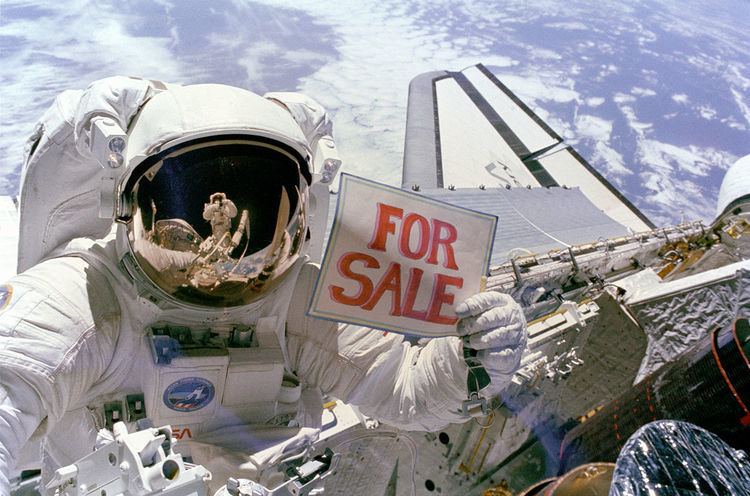 | ||
Space advertising is the use of advertising in outer space or related to space flight. While there have only been a few examples of successful marketing campaigns, there have been several proposals to advertise in space, some even planning to launch giant billboards visible from the Earth. Obtrusive space advertising is the term used for such ventures.
Contents
Attempts
The launch of Soyuz TM-11 in 1990 carried Toyohiro Akiyama, a reporter for the Japanese television network Tokyo Broadcasting System. The network paid for his seat on the flight and its logo was featured prominently on the third stage of the Soyuz-U2 launch vehicle. The launch shroud was emblazoned with logos for Sony, Unicharm, and Otsuka Pharmaceutical.
The 1993 "Space Billboard" by the American company Space Marketing Inc. was a proposal for a 1 km² illuminated billboard that would be launched into a low orbit and be visible from Earth. The advertisement would be roughly the same apparent size and brightness as the moon and was to be made from sheets of mylar. It was estimated that it would be impacted by space debris around 10,000 times; this and the inability to attract adequate funding prevented the project from progressing.
The first commercial filmed in space was a milk commercial by the Israeli company Tnuva, which was filmed aboard the space station Mir in 1997.
In an unusual form of fast food advertising, two Pizza Hut marketing ploys have involved spaceflight. In 2001 they were the first to deliver pizzas to outer space when their vacuum-sealed food arrived at the International Space Station, just a year after signing a deal to have a 30-foot (9 m) Pizza Hut logo placed on the side of the unmanned Proton rocket that launched Zvezda module. Kodak then paid to have their logo and a slogan placed onto a material that was to be tested for durability in space on the outside of the International Space Station.
The team White Label Space competing in the Google Lunar X PRIZE plans to raise the money for its Moon mission from space advertising in the form of sponsorship by one or more large global brands.
Legislation
In 1993, faced with the Space Billboard project, U.S. Congressman Ed Markey introduced a bill that banned all U.S. advertising in space. This was amended by Section 70102 of title 49 of the United States Code to only cover obtrusive advertising, thus allowing sponsorship deals where the logo is placed on the rocket or an astronaut's clothing. Since May 2005 the Federal Aviation Administration (FAA) has been in charge of enforcing this law.
Russia is the other leading space flight country, and has accepted advertising on many of their missions (see Attempts above).
Criticism
Before the legislation was introduced there was a public outcry to reports of obtrusive space advertising plans. The problems caused for astronomy due to light pollution, obstructed vision, and radio noise were quickly cited. The inability to easily avoid the advertisements was another great concern, with them being in sight in all locations outside – all other forms of advertising can be turned off or removed somewhat easily. As large billboards would be visible for large distances it would also be impossible to make them visible to only one country.
Popular culture
Large billboards in space have been featured in several science fiction books, films and television series, most notably the animated series Futurama. They are usually shown as satire of commercialisation.
In Fredric Brown's 1945 short story, "Pi in the Sky," an inventor rearranges the apparent positions of the stars to form an advertising slogan.
In Robert A. Heinlein's 1951 novella The Man Who Sold the Moon the protagonist raises funds for his lunar ambitions by publicly describing means of covering the visible lunar face in advertising and propaganda, and then taking money not to do so.
In Isaac Asimov's 1958 short story Buy Jupiter, a group of extraterrestrials broker a deal with the governments of Earth to purchase the planet Jupiter so that they could use it as an advertisement platform to the starships from their worlds that passed by the planet.
A Red Dwarf novel features an advertising campaign whereby a ship is sent on a mission by The Coca-Cola Company to cause 128 stars to go supernova in order to visibly spell the words "Coke Adds Life!" across the sky on earth. The message is intended to last five weeks, and be visible even in daylight.
In an episode of Carmen Sandiego's television show, she plans to launch rockets to transform the moon's face into the show's logo.
